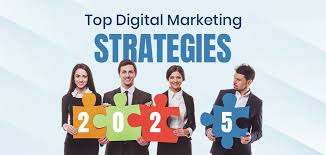Introduction
In the fast-paced world of 2025, small businesses in the USA face unprecedented challenges and opportunities in digital marketing. With evolving consumer behaviors, technological advancements, and increasingly sophisticated algorithms, it’s essential for small businesses to keep up-to-date with the latest digital marketing strategies to stay competitive.
Digital marketing is no longer optional — it is the backbone of customer acquisition, brand awareness, and revenue growth. Consumers expect personalized, fast, and relevant experiences across multiple digital channels. For small businesses, the ability to adapt and implement effective marketing strategies can mean the difference between thriving and struggling.
This article explores the top digital marketing strategies every small business in the USA must adopt in 2025. We’ll discuss everything from AI-driven personalization and short-form videos to local SEO, voice search optimization, social commerce, and performance tracking. By the end, you’ll have a comprehensive roadmap to supercharge your digital marketing efforts in the modern era.
Digital marketing today is more complex and data-driven than ever before. Small businesses no longer simply rely on organic traffic and generic advertising; instead, they must embrace a multifaceted approach that includes technology, creativity, and analytics.
According to recent research, over 80% of consumers research products online before buying, and over 70% expect brands to deliver personalized experiences. Furthermore, mobile devices and voice assistants have shifted how consumers search for and discover products, emphasizing the importance of mobile-first and voice-friendly marketing.
The competition is fierce, but the tools and tactics available are also more powerful. Small businesses that embrace innovation and focus on customer-centric marketing will lead the pack.
2. Key Digital Marketing Strategies for Small Businesses in 2025
A. Hyper-Personalization Using AI
Hyper-personalization goes beyond inserting a customer’s name in an email. Thanks to advances in artificial intelligence and machine learning, small businesses can analyze vast amounts of customer data to tailor marketing messages, offers, and product recommendations at an individual level.
By leveraging AI-powered platforms, you can:
- Track browsing behavior and purchase history
- Segment audiences with precision
- Automate personalized email sequences and ads
- Optimize content recommendations in real time
For example, a local bookstore can use AI to suggest books based on past purchases and browsing preferences, increasing customer satisfaction and repeat business. Personalized marketing campaigns have shown to increase conversion rates by up to 20%, making this a must-have strategy in 2025.

B. Short-Form Video Marketing
Short-form video content has exploded in popularity thanks to platforms like TikTok, Instagram Reels, and YouTube Shorts. These videos are engaging, quick to consume, and highly shareable, offering small businesses a cost-effective way to reach and engage their audience.
Key advantages of short-form video marketing include:
- Higher engagement rates compared to static posts
- Ability to showcase products, tell stories, and build brand personality
- Increased organic reach through viral sharing
- Easier creation and lower production costs than traditional videos
Small businesses can use short videos to:
- Showcase new or best-selling products
- Share behind-the-scenes footage
- Provide quick tips or tutorials related to their offerings
- Highlight customer testimonials and reviews
Creating a consistent stream of authentic, creative short videos can greatly boost your online presence and customer connection.
C. Local SEO and Voice Search Optimization
Most small businesses rely heavily on local customers, making local SEO a critical part of any marketing plan. Optimizing for local search ensures your business appears when nearby customers look for products or services you offer.
To optimize local SEO, small businesses should:
- Claim and fully optimize their Google Business Profile, ensuring accurate contact info, hours, photos, and regular updates
- Encourage satisfied customers to leave positive reviews, which influence local rankings and customer trust
- Use location-specific keywords in website content and metadata, such as “best coffee shop in Austin”
- Create localized content focused on community events, news, or guides
Voice search is another rapidly growing area. With smart speakers and virtual assistants becoming household staples, consumers increasingly use natural language voice queries like “Where can I find a good plumber near me?” or “Best pizza delivery nearby.”
To optimize for voice search:
- Use conversational keywords and phrases that mirror how people speak
- Incorporate FAQs and question-answer formats on your website
- Ensure your site is mobile-friendly and loads quickly, as voice search is often mobile-based
Together, local SEO and voice search optimization can dramatically increase foot traffic, phone inquiries, and online sales for small businesses.

D. Content Marketing with Value-Driven Approach
Content marketing remains a foundational pillar of digital success. However, the quality and relevance of content have become paramount. Small businesses need to focus on creating valuable, helpful, and engaging content that truly addresses the needs and pain points of their target audience.
Effective content strategies include:
- Publishing in-depth blog posts that answer common customer questions
- Creating step-by-step guides, tutorials, and how-to videos
- Developing infographics and visuals that simplify complex information
- Producing case studies and success stories that showcase your expertise
- Leveraging content formats optimized for featured snippets and voice assistants
A value-driven content approach helps establish authority, build trust, and improve SEO rankings over time.
E. Social Commerce Integration
Social commerce — selling products directly through social media platforms — has become a major trend. Platforms like Instagram, Facebook, and Pinterest allow businesses to create shoppable posts, stories, and ads, simplifying the path from discovery to purchase.
Small businesses should:
- Set up fully optimized social media shops
- Tag products in posts and stories to allow direct purchases
- Host live shopping events to engage audiences and boost sales
- Use targeted social ads to reach highly relevant audiences
Social commerce shortens the sales funnel and leverages the power of social proof and impulse buying, making it a potent tool for small businesses.
The rise of AI has transformed digital marketing, especially for small businesses that often have limited time and resources. AI-powered tools automate repetitive tasks, provide deep customer insights, and enhance creativity.
Popular AI tools include:
- Chatbots that provide instant, 24/7 customer support and lead qualification
- Email marketing platforms that automatically tailor messages and send times based on user behavior
- Analytics dashboards that visualize key metrics and recommend actions
- Content generators and editors that assist in producing SEO-friendly blogs, social posts, and ads
Using AI enables small businesses to scale marketing efforts, improve customer engagement, and make smarter decisions.
4. Measuring and Analyzing Performance
Tracking and measuring the success of your marketing efforts is vital. Without data, it’s impossible to know what’s working or how to improve.
Key performance indicators (KPIs) to monitor include:
- Website traffic and average session duration
- Bounce rates and exit pages
- Conversion rates for purchases, form submissions, or calls
- Social media engagement metrics like likes, shares, comments, and follower growth
- Return on investment (ROI) for paid campaigns
Use tools like Google Analytics, social media insights, and email marketing reports regularly. Analyze this data to optimize campaigns, allocate budgets effectively, and maximize ROI.

5. Overcoming Common Challenges for Small Businesses
While digital marketing offers many opportunities, small businesses often face obstacles such as:
- Limited budgets and tight resources
- Lack of marketing expertise
- Time constraints and competing priorities
- Rapidly changing technologies and trends
To overcome these challenges:
- Prioritize high-impact, low-cost strategies first (e.g., local SEO, social media engagement)
- Use free or affordable tools to automate tasks and track performance
- Invest in ongoing education through webinars, courses, and industry blogs
- Partner with freelancers or small agencies for specialized help if needed
- Focus on consistent execution and continuous improvement
Remember, marketing success is a marathon, not a sprint.
Conclusion
Digital marketing in 2025 offers small businesses in the USA unprecedented opportunities to grow, engage customers, and increase revenue. By embracing AI-powered hyper-personalization, creating engaging short-form videos, optimizing for local and voice search, integrating social commerce, and continuously analyzing performance, small businesses can position themselves for long-term success.
Start planning and implementing these strategies today to stay ahead in the ever-evolving digital landscape. Your customers are online — it’s time to meet them there with the right message, at the right time, on the right platform.







